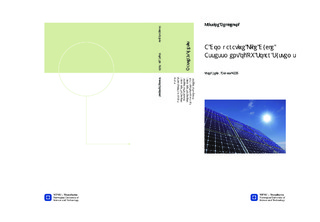| dc.description.abstract | In this report, a comparative life cycle assessment (LCA) of a rooftop, grid-connected photovoltaic (PV) system has been conducted. The primary objective has been to assess the environmental impacts resulting from the PV system over its entire lifetime, while the secondary goal has been to perform a sensitivity analysis on selected parameters and compare the results with the impacts from wind power. Four different cases have been assessed: Mc-Si Sim, mc-Si ESS, CdTe and CIGS. The difference between the multicrystalline silicon (mc-Si) cases were the production method for solar grade silicon: One case used the most common, chemical method; the modified Siemens process (mc-Si Sim), while the other case used the metallurgical route developed by Elkem Solar (mc-Si ESS).With a few minor exceptions, mc-Si Sim gave the highest environmental impacts, including the global warming impacts (GWP). The thin film technologies, CdTe and CIGS, had significantly lower impact potentials than the mc-Si cases, while the difference between the two were small. The relative contribution from processes to the impacts scores were different within each case investigated: The energy intensive steps for silicon purification were large contributors in the mc-Si cases, in addition to the PV module manufacturing, which was the dominating contributor in the thin film cases. In all cases, the metal depletion potential was dominated by the inverter and cabling components, due to their use of metals like copper and tin. Metallizarion pastes used in the mc-Si solar cell production contributed to toxicity potentials. Contributions from other processes in the PV value chains were less significant. The GWP-scores in kg CO2-eq./m2 of PV system were found to be 260 for mc-Si Sim, 155 for mc-Si ESS, 75 for CdTe and 86 for CIGS. Main contributors were the energy feed stock used in the solar grade silicon production (mc-Si cases), and the primary aluminium and glass used in manufacturing of the PV module (all cases). A base case was used for comparison with existing LCA studies, giving corresponding GWP-scores of 42,5, 30,8, 16,8 and 20,6 g CO2-eq./kWh, which are within the range of published values.The current thin film technologies are already competitive with wind power in terms of GWP. By performing different combinations of improvement measures, all cases, except mc-Si Sim, could achieve GWPs as low as 5,1-5,8 g CO2-eq./kWh (below the minimum value of wind power). Switching the electricity supply towards a higher share of renewable energy and improving in the conversion efficiencies will have a significant effect in reducing the GWP. To improve the material efficiency, manufacturing waste should be reduced and recycled, and the solar cells should be made thinner. The silicon purification methods need to be made more energy efficient by e.g. implementing energy recovery, using biogenic carbon sources as reduction agents or switch from using the modified Siemens method to using more energy efficient methods like the Elkem Solar Silicon production process or the Fluidized Bed Reactor process. Recycled aluminium or steel should be used for the frame of the PV module and the mounting structure. End-of-life PV modules should be recycled to reduce the demand for primary material, e.g. aluminium, glass and rare metals. | nb_NO |

